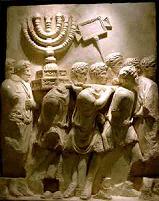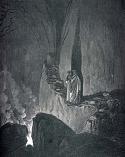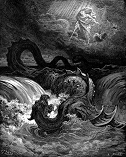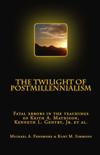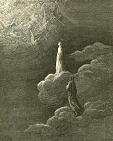Excerpts from God's Prophetic Word
Matthew Twenty-four and The Destruction of Jerusalem
by Foy E. Wallace Jr.
Before going into the details of Matthew 24 to show that the signs of
that chapter refer to the fall and destruction of Jerusalem, a look
into some Old Testament passages leading up to it will lay a
foundation upon which to stand and at the same time answer some
questions which some will be sure to ask. Let us take a look at the
background.
(1) In the Old Testament - Zech. 14.
We shall not here read the chapter, but rather refer to its contents
verse by verse. Zechariah 14 is almost universally used as "a second
coming of Christ chapter" but it is a "destruction of Jerusalem
chapter" instead.
Verse 1: "Behold, the day of the Lord cometh, and thy spoil shall be
divided in the midst of thee."
The symbolic "day of the Lord" here is the same expression precisely that
is used in Isa. 13:9 in reference to the destruction of Babylon. If
the destruction of Babylon could be called "the day of the Lord,"
why not the destruction of Jerusalem? That expression does not mean
the second coming of Christ in either of these passages. Compare
Isaiah 13 as a prophecy against Babylon, Isaiah 17 as a prophecy
against Damascus, Isaiah as a prophecy against Ethiopia, Isaiah 19
as a prophecy against Egypt, with Zechariah 14 as a prophecy against
Jerusalem, and it can be seen that the assertions of the
Millennialists that Zechariah is prophesying the second coming of
Christ and the millennium are wrong.
Verse 2: "For I will gather all nations against Jerusalem to battle; and
the city shall be taken, and the houses rifled, and the women
ravished; and half of the city shall go forth into captivity, and
the residue of the people shall not be cut off from the city."
The historical accounts of the siege of Jerusalem by Josephus, Pliny,
Horne and Clarke fulfill Zechariah's descriptions.
Reference to "nations gathered for battle" is a description of besieged
Jerusalem, the houses rifled and the women ravished. The same
description is found in Isaiah 13, verses 15 and 16, concerning the
fall and destruction of Babylon. The comparison is forceful.
Verse 3: "Then shall the Lord go forth, and fight against those nations,
as when he fought in the day of battle."
Factually, all the nations were represented in the Roman army, and God
afterward fought against them by means of the Northern nations. Read
Zech. (14-15: "And the Lord shall be seen over them, and his arrow
shall go forth as the lightning; and the Lord God shall blow the
trumpet, and shall go with whirlwinds of the south. The Lord of
hosts shall defend them; and they shall devour, and subdue with
sling stones." The visitations are figurative, of course, but
nevertheless significant of the fact that all the nations referred
to "against" whom the Lord "fought" were destroyed.
Verse 4: "And his feet shall stand in that day upon the mount of Olives,
which is before Jerusalem on the east, and the mount of Olives shall
cleave in the midst thereof toward the east and toward the west, and
there shall be a very great valley; and half of the mountain shall
remove toward the north, and half of it toward the south."
The prophetic declaration that "his feet shall stand in that day upon the
mount of Olives which is before Jerusalem," does not refer to the
second coming of Christ but rather to the siege of Jerusalem. Jesus
Christ stood with his feet on the mount of Olives when he uttered
the doom of the city. The Roman general stood on the Mount of Olives
when Jerusalem was besieged. The formations of the battle lines,
entrenchments and redoubts, the circumvallations of the Romans, all
enter into the graphic description and portrayal of the prophet that
the mount should "cleave in the midst" and "toward the north" and
"toward the south."
Verses 5-7: "And ye shall flee to the valley of the mountains; for the
valley of the mountains shall reach unto Azal: yea, ye shall flee,
as ye fled from before the earthquake in the days of Uzziah king of
Judah: and the Lord my God shall come, and all the saints with thee.
And it shall come to pass in that day, that the light shall not be
clear, nor dark: but it shall be one day which shall be known to the
Lord, not day, nor night: but it shall come to pass, that at evening
time it shall be light."
Obviously, these verses are a metaphorical description of the mixture of
divine mercy with justice. After the visitation there would be light
- the diffusion of divine knowledge. This did follow the fall of
Jerusalem and the destruction of the Jewish state.
Verses 8-9: "And it shall be in that day, that living waters shall
go out from Jerusalem; half of them toward the former sea, and half
of them toward the hinder sea: in summer and winter shall it be. And
the Lord shall be King over all the earth: in that day shall there
be one Lord, and his name one."
The only consistent application of this language is a spiritual
fulfillment in the gospel of Christ and the church. Who is ready to
deny that the clause "in that day shall there be one Lord, and his
name one," refers to the present dispensation? There is one Lord,
his name is one, and the Lord is "king over all the earth." It finds
its fulfillment in the church of Christ where there is neither Jew
nor Gentile, but all one in Christ, and one Lord over all.
Verses 16-17: "And it shall come to pass, that every one that is left of
all the nations which came against Jerusalem , shall even go up from
year to year to worship the King, and Lord of hosts, and to keep the
feast of tabernacles. And it shall be, that whoso will not come up
of all the families of the earth unto Jerusalem to worship the King,
the Lord of hosts, even upon them shall be no rain."
If these verses are not figurative, if they are to be taken literally,
then all nations and families must literally go up to Jerusalem and
literally offer animal sacrifices and keep the Passover, restore
Judaism with all of its literal ceremonies, in order to fulfill the
prophecy. That would be a complete reestablishment of old Judaism
and everything that characterized it, all of which was taken away.
But if these verse are not literal, then the application made of the
whole chapter by the Millennialists loses its force. These last
verses refer to the expansion of the blessing of the gospel
dispensation after the destruction of Jerusalem. Upon all who
received the gospel, its blessings descended as rain; but to the
unbelievers who rejected the gospel "upon them shall be no rain" -
all such are barred from its promises and privileges.
The simple truth of the matter is that as Isaiah 13 is a prophecy on the
destruction f Babylon, Zechariah 14 is a prophecy on the destruction
of Jerusalem. It does not teach millennialism in a sentence or a
syllable.
(2) In the New Testament. - Matt. 24
Each sign listed on this chart has special application to the then
impending destruction of Jerusalem.
When Matthew 24 is taken away from the Premillennial preachers their
argument on the imminent return of the Lord based on "the signs of
the times" is torn away from them, and their sources of speculative
supply is cut off. A verse by verse study will do it:
1. False teachers - verse 5. "For many shall come in my name, saying I am
Christ; and shall deceive many." Jesus simply warned the disciples
that false teachers would be numerous, more than ever before.
Josephus, the historian, verifies the fact that near the time of
Jerusalem's fall, many false Messiahs appeared, claiming to be the
Christ. He says these became more numerous before the sieges of
Titus. Luke, the historian, records such pseudo-signs and false
wonders as the magical deceptions of Simon Magus - Acts 8 - which
were employed on the professional deceivers mentioned in the Lord's
predictions.
2. Wars and rumors of wars - verse 6: "And ye shall hear of wars and
rumors of wars." Many smaller nations were at war with the Romans at
that time, enemies at war with each other and rumors of war in
abundance on every hand, and from every quarter as the destruction
of Jerusalem drew near. Josephus verifies the fact that from every
part of the empire wars followed in succession, and in waves of
revolt, like the swells of the ocean, to the final dissolution of
the empire.
3. Famine and
pestilence - verse 7: "For nations shall rise against nation, and
kingdom against kingdom: and there shall be famines, and
pestilences, and earthquakes, in divers places." In the days of
Claudius Caesar, before the destruction of Jerusalem, there was a
unparalleled famine - the greatest famine the world ever knew
occurred. The record of Matthew 24 is corroborated by the Spirit in
Agabus, the prophet, as reported by Luke in Acts 11:28: "And there
stood up one of them named Agabus, and signified by the Spirit that
there should be great dearth throughout all the world: which came to
pass in the days of Claudius Caesar."
Again Josephus testified that the famine actually occurred before the
destruction of Jerusalem, and the fulfillment is a matter of
historical record.
4. Earthquakes - verse 8: "All these are the beginning of sorrows." That
great earthquakes occurred during the reign of Nero is a historical
fact, and the testimony of Jesus is added to that of Josephus of an
unusual number of earthquakes occurring in various countries, before
the destruction of Jerusalem. Many cities of Asia Minor were
destroyed by earthquakes.
5. Delivered to death - verse 9: "Then shall they deliver you up to be
afflicted, and shall ki8ll you: and ye shall be hated of all nations
for my name's sake." Paul, Peter, and James, and James the Less were
all put to death before the destruction of Jerusalem.
6. Apostasies - verse 10: "And then shall many be offended, and shall
betray one another, and shall hate one another." This is the Lord's
warning of many apostasies, when the faith of the disciples would
fail, as under pressure of persecution many should become offended.
Such apostasies were everywhere in evidence prior to the destruction
of Jerusalem, the evidences of which are not only mentioned in the
sacred text, but in parallel secular history. the most valuable of
such historical evidence is the testimony of Josephus, who was an
eye-witness to the destruction of Jerusalem.
7. The gospel to all the world - verse 14: "And this gospel of the
kingdom shall be preached in all the world for a witness unto all
nations: and then shall the end come." Within this period of gospel
history the sound of the messengers' feet had been heard all over
the Roman world - Rom. 10:15 - and the gospel was, in fact, preached
to the whole creation before the destruction of Jerusalem. Read Col.
1:23: "If ye continue in the faith grounded and settled, and be not
moved away from the hope of the gospel, which ye have heard, and
which was preached to every creature which is under heaven; for
which I Paul am made a minister." Hence, before the death of Paul
this "sign" was actually fulfilled - literally enough, indeed, to
satisfy the most exacting literalist. Eusebius says "The gospel was
like the sun, enlightening the world at once." It was universally
published; the Gentile nations were illuminated with Christianity,
providing the events to correspond with the prophecies, a fact so
striking as to be convincing without disputation.
8. The end of the Jewish world – verse 14: “Then shall the end come.”
Here, at once, with one accord, the Millennialist jumps to the
conclusion that this “end” means the end of the world – “then shall
the end come” – but the end of what? The end of Jerusalem; the
destruction of the temple and the end of the Jewish state and the
end of Judaism. Please turn the chart.
9. The abomination of desolation – verse 15: “When ye therefore shall see
the abomination of desolation, spoken of by Daniel the prophet,
stand in the holy place, (whoso readeth, let him understand.” This
description refers to the heathen symbols and Roman standards raised
in the temple. When the Romans conquered the city, and entered it,
the Roman soldiers marched into the temple, and raised instead the
symbols and standards of paganism and Romanism. That is what was
called the abomination of desolation standing in the holy place. The
“abomination of desolation” was fulfilled when those Roman standards
and pagan symbols were seen in the holy place “where they ought not
to be.”
10. The disciples flee – verses 16-18: “Then let then which be in Judea
flee into the mountains: let him which is on the housetop not come
down to take any thing out of his house; neither let him which is in
the field return back to take his clothes.” The destruction of
Jerusalem was regarded by all pious Jews as pestilence and
desolation and was taken as a sign at the time for them to escape
had come – to do what Jesus had warned them to do – to flee to the
mountains. The disciples did as Jesus said – they heeded the
warnings and fled. From the flat roots of their houses in the city
or from their fields in the country, they saw the Roman army in full
march, there was no time to go inside for goods or raiment. Life was
more than personal property. When they saw the sign of the standards
and symbols of the Romans in the temple, they remembered that Jesus
had warned them of that very thing, and at the news of the Roman
approach they fled to Pella, the northern boundary of Perea.
It is a remarkable but historical fact that Cestius Gallus, the Roman
general, for some unknown reason, retired when they first marches
against the city, suspended the siege, ceased the attack and
withdrew his armies for an interval of time after the Romans had
occupied the temple, thus giving every believing Jew the opportunity
to obey the Lord’s instruction to flee the city. Josephus the
eye-witness, himself an unbeliever, chronicles this fact, and
admitted his inability to account for the cessation of the fighting
at that time, after a siege had begun. Can we account for it? We
can. The Lord was fighting against Jerusalem Zech. 14:2: “For I will
gather all nations against Jerusalem to battle; and the city shall
be taken, and the houses rifled, and the women ravished; and half of
the city shall go forth into captivity, and the residue of the
people shall not be cut off from the city.” The Lord was besieging
that city. God was bringing these things to pass against the Jewish
state and nation. Therefore, the opportunity was offered for the
disciples to escape the siege, as Jesus had forewarned, and the
disciples took it. So said Daniel; so said Jesus; so said Luke; so
said Josephus.
As so it was – it was left for Titus, the Roman general, to execute the
siege, after the faithful disciples had fled. Verses 19-22: “And woe
unto them that are with child, and them that give suck in those
days! But pray ye that your flight be not in the winter, neither on
the Sabbath day: For then shall be great tribulation, such as was
not since the beginning of the world to this time, no, nor ever
shall be. And except those days should be shortened, there should no
flesh be saved: but for the elect’s sake those days shall be
shortened.” These verses deal with the hindrances to flight from the
besieged city, the tribulation of the sieges, and the lifting of the
sieges for the escape of the disciples.
11. Pseudo-signs - verses 23-26: "Then if any man shall say unto you, Lo, here is Christ, or there; believe it not. For there shall arise false Christs and false prophets, and shall show great signs and wonders; insomuch that, if it were possible, they shall deceive the very elect." Here was the Lord's warning against deceivers, fake prophets, false alarms and fraudulent signs - the forewarnings to tenable the disciples to discriminate between the spurious and the genuine. "Behold, he is in the desert; go not forth: behold, he is in the secret chambers; believe it not." These warning observed by the disciples of the Lord enabled them to escape the traps incident to the approaching siege.
12. The eagles and the carcass - verses 27-28: "For as the lightning cometh out of the east, and shineth even unto the west; so shall also the coming of the Son of man be. For wheresoever the carcass is, there will the eagles be gathered together."
The coming here refers to the approach of the Roman armies. The Jewish nation was the carcass which the Roman eagles were sent to devour.
These verses describe the swiftness of the events and the suddenness of all the occurrences connected with the siege of Jerusalem. The illustration of the eagles gather where the carcass is found, is a figurative description of the Romans as the eagles swarming over Jerusalem and Judea as the carcass, to loot and spoil the city and all the land of Judea.
13. After the tribulation - verse 29: 'immediately after the tribulation of those days shall the sun be darkened, and the moon shall not give her light, and the stars shall fall from heaven, and the powers of the heavens shall be shaken." After the tribulation of these days - that is, after the things that occurred during the siege. The siege began August 10, A.D. 70, six hundred year after Nebuchadnezzar's siege and destruction of first temple. All of the houses and underground chambers were filled with putrefied corpses. One million one hundred thousand people perished, and the remnants were scattered. Think of it - in only two months with only two armies fighting in the limited areas around Jerusalem, one million one hundred thousand people perished. Every building was filled with perishing bodied; famished people ate the putrefied flesh of human carcasses; mothers at the flesh of their own babies. And outside the besieged city the families of the expatriated race of Jews in many places throughout the empire were slaughtered. Josephus, the historian, verifies the fact that there was never anything like it before or since, nor ever shall be.
The signs in the heavens, the darkening sun and falling stars, refer to the falling of Jewish dignitaries, casting down of authorities and powers, long established, and signified the darkness that settled upon the Jewish state.
The sun of the Hebrew temple was darkened, the moon of the Jewish commonwealth was as blood, the stars of the Sanhedrin fell from their high seats of authority. Isaiah and Joel describe the ruin of both ancient Babylon and Jerusalem in similar description, in Isa. 13 and Joel 2.
14. The coming of the Son of Man - verse 30: "And then shall appear the sign of the Son of man in heaven: and then shall all the tribes of the earth mourn, and they shall see the Son of man coming in the clouds of heaven, with power and great glory."
The sign of the Son of man in the heaven was a signal, the evidence of divine visitation and intervention in the downfall of the Jewish authorities and in all the transpiring events. The mourning of the tribes of the earth refers to the lamentations of the Jewish families all over the world because of the destruction of their city and their temple and their state. The coming of the Son of man in the clouds of heaven is not a reference to the second coming of Christ but to the coming foretold by Jesus to Caiaphas in Matt. 26:24: "Hereafter shall ye see the Son of man sitting on the right hand of power and coming in the clouds of heaven." Jesus told Caiaphas that he could see, it, he would be a living witness to these events. The reference to the Son of man coming "with power and great glory" and "sitting on the right had of power" is emphasis on the magnitude of the things that occurred. The Son of man came in power in the transpiring events.
15. Sending forth his angels - verse 31: "And he shall send his angels with a great sound of a trumpet, and they shall gather together his elect from the four winds, from one end of heaven to the other." Here is the grand announcement of the world-wide success of the gospel, the universal expansion of the Christianity after the destruction of Jerusalem. The angels of this verse were messengers, emissaries of the gospel. The gathering of the elect from the four winds meant that these messengers would carry the gospel to every nook and corner of the inhabited world. This is the history of what occurre3d. With the downfall of Judaism the greatest foe of the church was removed, and path cleared of the chief obstacle, resulting in the universal sweep of Christianity. The knowledge of God covered the earth as waters cover the sea.
16. The signs that it was near - verse 32-33: "When the branch is yet tender...ye know that summer is nigh...so likewise ye, when ye shall see all these things, know that it is near, even at the doors." The signs of the approaching events would serve as portents to all faithful disciples that the things of which they were being warned would be near. The disciples would recognize these signs up to the time of the siege, and would know that it was "near, even at the doors." It is here that Luke's account says: "When these things begin to come to pass, then look up, lift up your heads; for your redemption draweth nigh" - Luke 21:28. The providential means for the escape of the faithful was divinely prearranged and when they should see these things "begin to come to pass" they were told to "look up" and "lift up" their heads in full confidence that their redemption, their deliverance, was at hand. This redemption extended beyond the mere escape from the siege - it was a greater deliverance from the persecutions of the Jewish authorities and the oppositions of Judaism, brought to an end by the fall of Jerusalem and the destruction of the Jewish state.
To say that the expression "it is near" refers to the end of the world, the end of time, or a "rapture" theory is contrary to the context of Matthew 24. When these signs appeared the Lord said, "Let them which are in Judea flee" - and they did. "And when ye shall see Jerusalem compassed with armies, then know that the desolation thereof nigh" - and they did know it. I fit meant the end of the world, whey say "let them which are in Judea flee to the mountains"? and why say, "let them which are in the midst of Jerusalem depart out of it"? and why say, "let not them that are in the country enter thereinto" - into Jerusalem? These sayings show clearly that the whole thing is a description of the destruction of Jerusalem. Reverting in verses 41 and 42 to these surrounding the Lord said that where two would be "in the field," or "grinding at the mill" - one would be taken and the other left - that is, the believing disciples would recognize the signs and take flight, while the unbelieving companion would remain and perish in the siege.
The statement that all the tribes of the earth shall mourn, as has been previously explained, is a reference to the Jewish families scattered all over the Roman empire - they would mourn the downfall of Jerusalem and the end of their Jewish commonwealth.
17. All these things fulfilled - verse 34: "Verily I say unto you, This generation shall not pass, till all these things be fulfilled." In Lk. 21:31-32, the Lord said: when YE see, and know Ye, and I say unto YOU - so here is the Lord's won statement of the period to which "these things" belonged and during which they would all be fulfilled. All of the "signs" mentioned in Matt. 24 are mentioned above verse 24. After having mentioned these signs, Jesus then said, "this generation shall not pass, till all these things be fulfilled." Notice - "all these things" - not some of them - all of them would be fulfilled before that generation passed. But we are told that "this generation" meant that race - meaning only that the race of the Jews would not pass till all this was fulfilled. The Lord would not be guilty of such a truism - telling the Jews what would happen to their race, and then saying the the race will not pass away until everything that will happen to the race happens to it! A truism would not be the word for that. It is sheer nonsense to have Christ say that certain things would happen to the Jewish race, but the Jewish race w2ould not pass away until what would happen to the Jewish race happened to it! No, Jesus said "this generation" - the generation living \then - would not pass "till all these things be fulfilled." The Lord's use of the same language after pronouncing the woes on the Pharisees in the previous chapter of Matthew shows clearly the reference was to their own time. There are nine woes pronounced upon these Jewish officials in Matthew 23, which are followed by verse 36: "verily I say unto you, all these things shall come upon this generation." Immediately following this statement is the pronouncement on Jerusalem in verse 37, "O Jerusalem, Jerusalem," and the verdict of verse 38, "Behold, your house is left unto you desolate." there is but one conclusion, and it is clear - all the woes of Matthew 23 and all the signs of Matthew 24 referred to that generation of time and span of life, and were all fulfilled in the destruction of Jerusalem, and immediately thereafter.
To receive Kurt Simmons’ e-mail newsletter, The Sword & The Plow, click the Subscribe link:
All rights reserved.
